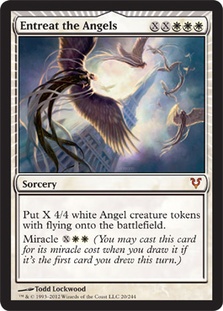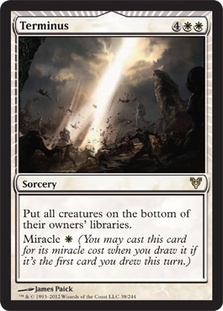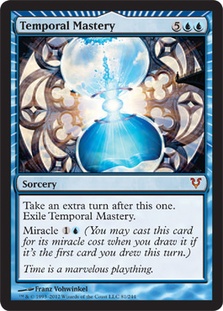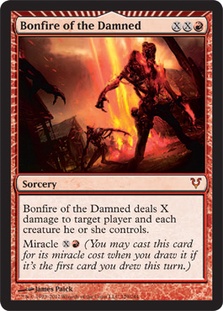I’d like to spend a moment to briefly hit on a subject that is near and dear to our collective hearts. I’m talking about the topic that has spawned much heated and impassioned debate in the Magic community as of late. If you hadn’t guessed by now, I’m referring to women in Magic. Rather than focus on the overall status of women in the Magic community, I’d like to instead single out one specific female character and the work she has put into making this a better game for everyone in the past year.
That woman is Hero of Bladehold.
I currently have the phrase "Hero of Bladehold 4 lyfe!" tattooed to my lower back, and I recommend that everyone else do the same. Let’s show our love and respect for the most midrangey of white creatures. Let’s demonstrate our gratitude to one who has truly gone above and beyond expectations the only way we know how…permanently inking that appreciation on our bodies. All I can ask is that each and every one of us does our part for the betterment of all. You can’t always change others, but you can always change yourself…irrevocably.
With that obligatory statement out of the way, I’d like to get into the meat of this article. It’s miracle time.
Luck Matters
We’re deep into spoiler season, and Avacyn Restored seems to focus on a few key motifs. Zendikar was a "land matters" set. Scars of Mirrodin was an "artifact matters" set. So what does Avacyn Restored bring to the forefront? What matters here? I think I can safely say that Avacyn Restored is a "being a complete lucksack matters" set.
Ripping off the top of your library and slamming the card into play to your opponents chagrin is at an all-time high. Rumors abound that this could finally be the set to wake up that miserly old man "Rip" Van Winkle from his top decking slumber. It could certainly draw him out by appealing to his peak performances as a Magician.
Personally, I’m of a bit of a mixed opinion about the miracle keyword. I can’t say I’m a fan of the added variance it can bring to a game of Magic, but in the same regard, I think it’s a unique restriction on deckbuilding and I’m interested to see what comes from it. I am sure that people will quickly figure out how to incorporate miracle cards in such a way that their drawback can be mitigated enough to make the powerful upside good enough.
I also think that miracle cards could breed better game play in general. If you draw a miracle card and stop to think about it before you put it in your hand, you have just tipped your opponent off that you drew a miracle card. If you choose not to play it, your opponent can still guess what it is based on the rest of the cards in your deck. I think a good skill to learn in the weeks to come is to think about what cards you could draw ahead of time and make a plan for what to do with each one before you draw them so you don’t give away needless information.
This skill is useful even without miracle cards. It’s useful now and it will be useful when miracle cards rotate out. A savvy opponent can often figure out what card you drew based on how long you stop to think about your turn. If you’re playing an established deck, your opponent is going to know the cards in your deck. It’s certainly possible that he or she is capable of figuring out what card you drew based on what cards in your deck could be tricky enough to give you pause to consider your options.
For example, I have had situations similar to this hypothetical come up in Block Constructed a number of times. I was playing against the R/W Aggro deck with RUG Control. The R/W deck had no creatures in play. I had a 2/2 Wolf token, a Snapcaster Mage, and a Garruk Relentless at one counter. I was at twelve life with one card in hand; my opponent was at fourteen life with no cards in hand. My opponent had seven lands in play and drew his card for the turn. He then went into the tank for a while on what to do.
There is only one card in that deck that could cause my opponent to tank on this turn, and that card is Devil’s Play. He could throw it at my face, putting me at six life, which lets him win if he draws two lands in a row for flashback or another Devil’s Play in the meantime. He could wait to draw another land, giving him enough to do twelve damage by casting Devil’s Play for seven and then flashing it back for five. Or he could cast it for one to finish off Garruk and then flash it back on the Wolf token to slow down my offense and give him time to draw more threats.
No other card in this situation gives my opponent these kinds of options. If he drew a creature, he just casts it. If he drew a Brimstone Volley, he could afford to wait until my turn to figure out how to best use it. If he drew a land, he could tank on it a bit to bluff it being a real spell, but most players would not tank too long on a land.
Even if my opponent decided to wait on the Devil’s Play, by spending so much time thinking he had still alerted me to the idea that he had it. I could now play accordingly. On my next turn I might use Garruk’s -1 ability to get a Huntmaster of the Fells to gain two life, whereas normally I would just +1 the Garruk to preserve him. By using the -1 ability, I play around him drawing a way to deal with Garruk followed by the lands to burn me out. I also increase my immediate clock even though I lose out on card advantage, which reduces the time my opponent has to draw more burn.
Knowing what’s in your opponents hand lets you play much more effectively. Spending a moment at the end of your opponent’s turn thinking about what cards you can draw and what you plan to do with them is a good skill to acquire, because it reduces the amount of information a good player can glean from you.
How to Properly Cast a Miracle Card
There is one thing that I do love about miracle. I have always had a bit of a flare for the dramatic, and I think this card can lead to some awesome dramatic scenarios.*
*For the record, I don’t recommend or endorse showboating or employing slow rolling techniques against people you don’t know or at an actual sanctioned tournament even against people you do know. This is just for some fun, good-natured ribbing amongst friends who are cool with it. I think it is fun to play like this with friends, but I would never actually do one of these against someone I don’t know and would consider it to be very unsporting to do so.
The first thing to note is that there is a wrong way to cast a miracle card. The wrong way is to reveal the card as you draw it, pay the mana cost, and cast it. I can say with certainty that this is the incorrect way to play it.
The right way to cast it is to use one of a couple of time-honored traditions that I will explain to you. Knowing these methods will give you an advantage over your opponents. It’s not an advantage in actual game play or skill, but an advantage in mental domination. Remember that putting your opponent on tilt is the most important factor in any game of Magic. Winning the game, as always, comes secondary.
The Called Shot
The first technique I want to discuss is the called shot. If you follow that link, you will see that this rich legacy has been around since the 1930’s. Allow me to demonstrate how it works by showing you a hypothetical scenario.
It’s round 1 of a SCG Legacy Open. One player has his RUG Delver deck ready to go. He’s prepared for the expected metagame. What he’s not prepared for is his opponent, who is dressed up as Babe Ruth, sitting across from him. The RUG Delver player is on the play and leads with a Tropical Island and a Delver of Secrets. That’s quite the start, but it’s not affecting the Bambino.
Unfazed, Babe Ruth, in the upkeep of his first turn, throws a Simian Spirit Guide down on the table and calls out, "Alright, one time. Just one time. I’m using my one time right here. Thunderous Wrath!" He then points off in the distance and slams a card off the top of his deck onto the table. It’s the Thunderous Wrath! The entire table erupts in cheers! He did it! He pulled off the called shot!
Taking your opponent to fifteen life hasn’t been this awesome since the last time you cast Lava Axe on your undamaged opponent in a Core Set Limited game.
Keep in mind that you’re going to fail the called shot more often than succeed. As a result, it’s of paramount importance that you use the called shot each and every time you are playing with people who have not seen you use it before to maximize value. That way, the few rare times you actually hit will make you look like the luckiest player alive.
I Can’t Think of the Word
This is one of my personal favorite slow rolls of all time. I spend significantly more time than any reasonably sane person could ever comprehend pondering game play situations where I can pull this off. There are actually two different methods for "I can’t think of the word."
Method #1
This method involves using the actual name of the card and is also the most commonly used. For the purpose of this demonstration, I will use the card Bonfire of the Damned.
The way it works is that as you draw the card and see that it’s Bonfire of the Damned and realize that you are going to cast it for its miracle cost, you ask your opponent a series of questions. The correct response to the questions should be the word "bonfire."
For example, you might ask the following: "Hey, so I was thinking of going to that outdoor party this weekend. I hear they are getting a huge pit to make a fire. What is that kind of a fire called? It’s on the tip of my tongue, but the word is just escaping me."
Your opponent will respond with something like: "Oh, are you talking about a bonfire?"
Then you say something like: "Yeah, that’s it. A bonfire." You pause a bit for dramatic effect at this point and generally look your opponent directly in the eye. Then you flip over Bonfire of the Damned, pay its mana cost, and say: "Bonfire of the Damned. X=5. I’ll destroy all of your creatures and redirect the damage to your planeswalker."
Your opponent might suffer burnout from playing Magic at this point.
Method #2
This is the less commonly used method, but it’s more effective when the name of the card isn’t something that easily lends itself to Method #1.
The way this works is exactly the same, but instead of having the answer to your series of questions be the name of the card, you want it to be a word like "blowout" that aptly describes how the card you’re about to cast will affect the board.
Example: you draw the card Terminus when your opponent has two Geralf’s Messengers, a Diregraf Captain, and a Gravecrawler in play. You might say this to your opponent: "I saw a car off on the shoulder when I was driving on the interstate today. It looked like one of the tires went flat and it spun out. I can’t think of the word for when a car has its tire pop when driving like that. Do you know what it is?"
Your opponent will politely inform you what the word is: "Oh, you mean a blowout?"
That is your cue to look them directly in the eye and say, "Yeah, it must have been a complete blowout." You tap a Plains to pay the mana cost of Terminus and say: "Terminus. Cards in hand? Oh, none? Ouch. What a blowout."
Your opponent may find him or herself bowing out from the event.
The Spelling Bee
This one is for advanced users only. Proper execution of The Spelling Bee involves a willing co-conspirator and the understanding that you will earn at least one slow play warning for this technique, which may or may not be upgraded to a DQ without prize. I assure you it’s worth it.
Your partner in this endeavor needs to be dressed in his or her best schoolteacher, school administrator, or librarian garb. Glasses or a monocle are a must in this costume. Your partner also needs to be holding a dictionary. As you draw a miracle card that you plan to cast that will completely destroy your opponent’s chance of winning the game, your partner needs to interrupt you and hold a mock Spelling Bee.
For example, you draw Terminus when the board state is the same as the above example. Your opponent has two Geralf’s Messengers, a Diregraf Captain, and a Gravecrawler. At this point, your partner jumps in and says: "Your next word for the Spelling Bee is Terminus."
You then ask them a series of questions about the word before ultimately spelling it and then casting the spell. At some point you are required to ask them to use it in a sentence. A sample conversation looks like the following:
Partner: "Your next word for the Spelling Bee is Terminus."
You: "What is the part of speech?" Your partner flips to Terminus in the dictionary at this point.
Partner: "Noun."
You: "What is the language of origin?"
Partner: "Latin"
You: "Can you define the word?"
Partner: "Terminus: the end or extremity of anything."
You: "Can you use it in a sentence?"
Partner: "Casting Terminus on a board that contains two Geralf’s Messengers, a Diregraf Captain, and a Gravecrawler when your opponent has no cards in hand is an extreme blowout and will probably be the end of their chances of winning this game."
At this point, you look at the Terminus you just drew and you spell the word correctly by reading from the card. You tap a Plains and cast the spell.
Your partner at this point says: "That spelling is correct." He or she should then turn to your opponent and say: "Your next word is GG."
That should spell the end of your opponent’s chance for progressing far in the tournament.
Insert Bad Miracle Pun Here
Now that I’ve covered the proper fundamentals for casting miracle cards, I’d like to actually talk about some of the miracle cards we have seen and applications I think they might have for Standard.
I want to preface by saying that I am a bit jaded that they printed the card Lightning Mastery without the miracle keyword. Come on WotC, that was your out to add the miracle keyword to Fire Whip and call it Miracle Whip. They definitely dropped the ball on that one.
With that out of the way, let’s get on to some of the real cards.
Entreat the Angels
I haven’t seen many people talking about this card. While I don’t think this card is going to break any formats, I do think it’s good. One archetype that I’m looking into is some kind of a tap out U/W Control deck, since I love the idea of playing Tamiyo and Gideon together. A card like Entreat the Angels seems like a great one- or two-of in that kind of an deck. Being a sorcery doesn’t matter a whole lot when your game plan is to just tap out every turn playing bigger and bigger haymakers.
Hard cast from your hand, it gives roughly the same returns as White Sun’s Zenith. At any value of X, you get the same amount of power added to the board as you would from a White Sun’s Zenith. What really pushes it over the edge, though, is the miracle ability on it. Even on turn 4, paying three mana for a 4/4 Angel is pretty good value.
Any turn after that and you get exceptional returns out of the card. I think in any late game situation, casting this for its miracle cost is probably better than anything else you could do that turn anyway, which means that this card is one of the few cards where you are probably going to want to just cast it for its miracle cost every single time you draw it.
Terminus
I don’t know about you, but this is one of the coolest card names I have seen in a while. The name alone just demands respect. The card itself I don’t expect to make any huge waves, but I do think it could be a reasonable one- or two-of in a control shell to supplement Day of Judgment. Most of the time I think you will want Day of Judgment, but I can see a few situations where you’d rather have this card and it might be right to run a mix of the two.
Temporal Mastery
At first, this card was overhyped and hailed as the end of Magic. At this point, enough respected Magic players have spoken out against it that I feel it may actually be currently underhyped. I don’t think this is a card that you can just throw into any deck, but I do think this is an amazing card to run in a ramp deck. Ramp decks can take advantage of extra turns very well. They have enough mana to do other things on the turn they miracle cast Temporal Mastery.
The times when Temporal Mastery is merely a glorified Explore is still a very good effect for a ramp deck. Ramp decks can reasonably hard cast this card later, where it will still be effective even at seven mana. The seven mana CMC of this card is a natural mana cost to follow up a Titan with. Finally, Titans are the perfect creatures to have in play while taking an extra turn, since they effectively give you a planeswalker level of value from attacking.
I’m excited about playing a blue based ramp deck with Frost Titan, Tamiyo, Temporal Mastery, and possibly even Dungeon Geists. Gerry Thompson discussed a U/G deck in his recent article, so I won’t dwell on this too much since I think he did a good job of discussing that prospective archetype. I was personally thinking of playing a U/G splash red shell rather than just straight U/G, since U/G/R gives you access to Kessig Wolf Run, sweepers, possibly Huntmaster or Inferno Titan (depending on the metagame), and Desolate Lighthouse.
Bonfire of the Damned
This card seems like a great answer to both Lingering Souls and planeswalkers since it can cheaply hit both at the same time. I suspect this card will see some play for doing exactly that, especially if Lingering Souls continues to play a big role in the format. Even at three mana, dealing one damage to a bunch of 1/1 Spirits is not terrible value if you can’t trigger the miracle on it. Slagstorm basically plays that role a decent amount of the time as it is.
Thunderous Wrath
I think this might actually be the best miracle card because the miracle cost is very cheap, meaning you can cast it every turn after turn 1 and the effect is much less situational than most of the other ones. You have to be playing it in the right shell, but in a Lava Spike deck this is the ultimate Lava Spike.
If all you want to do is cast burn spells at your opponent’s dome then you are just going to cast this every time you see it, and you’re not going to run into those tricky situations where you have to decide whether to cast the spell or hold onto it for later. Five damage is not insignificant. Anyone who has been prematurely ended by a flurry of Brimstone Volleys knows how quickly that adds up.
None of the other miracle cards that we’ve seen so far have struck me as being very exciting, but it’s hard to predict how good the mechanic will be. If it turns out that miracle is a lot better than expected, even cards like Fade Out or Devastating Tide could end up seeing some play. I wouldn’t write them off.
Before I end this article, there is one final thing I’d like to discuss. I’m talking about some two- or three-card "combos" that I want to see actually happen in a real game of Magic sometime in the next year. These are the all-important flavor combos.
Flavor Combos
Really? Again?: Exile Avacyn, Angel of Hope using Helvault with Sorin, Lord of Innistrad in play.
Gold Bond:One shot someone with Gisela, Blade of Goldnight paired up with Silverblade Paladin.
Gold Digger: Resolve a Gravedigger, returning Gisela, Blade of Goldnight to hand.
Bonds of Faith: Pair Avacyn, Angel of Hope with Silverblade Paladin
Bonded Fetch: Cast Rude Awakening, then cast Wolfir Silverheart and pair it with a Misty Rainforest.
The Student has become the Master: Sacrifice Griselbrand to Disciple of Griselbrand
Soul Survivor: At five or less life, pair Wolfir Silverheart with Village Survivors
Soulja Boy: Pair Squire with any soulbond creature.
Let me know if you can think of any other awesome flavor combos with Avacyn Restored that should be added to the list.
Thanks for reading, and may your miracles always put your opponent on life tilt.
BBD on Magic Online





